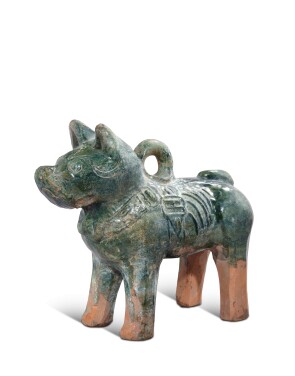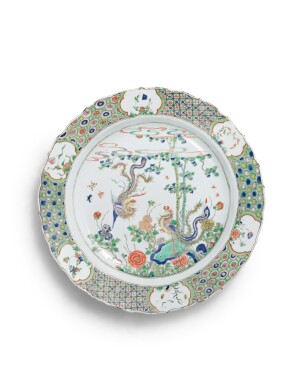I f pottery is the story of human civilisation, the history of Chinese ceramics spanning seven millennia is at once a study of socio-politics, geography, art and innovation. But its history does not fall into neatly contained chapters. Geographic borders shifted with war and invasion; and production at kiln sites followed this ebb and flow of power. A breakthrough in a new technique may take place in one period, only to supersede the established predominant method in another. A type of ware may be specific to an era in time, while others may traverse dynasties. Ceramics produced in China vary greatly from utilitarian wares for daily use and funerary rituals to exquisite pieces made for the Imperial court. Here, drawing on pieces from Masterpieces of Chinese Ceramics from the Ise Collection, is an explainer on what you need to know about the history of Chinese ceramics and essential information on the wares and glazes revered by collectors from each dynasty.
The Ise Collection – numbering close to 200 pieces – charts the history of Chinese ceramics beginning with Neolithic pottery of China’s prehistoric cultures and ending with the splendid enamelled porcelain of the Qing dynasty.
Assembled by the highly respected Japanese collector and tea master Mr. Hikonobu Ise, the Ise Collection is revered as one of the most distinguished private collections in the field, making its appearance on the market a truly exceptional opportunity for connoisseurs.

N eolithic pottery in China traces to the Yangshao culture (c. 4800-3000 BCE) in the Yellow River Basin, widely considered to be the cradle of Chinese civilisation. Wares primarily served the purpose of being functional vessels to hold water, fermented grain alcohol, food, and grain. The many early forms include stemcups, large open-mouth jars and footed stem bowls, the hu vase, and more. The tripod ewer, with its tapered legs and rounded body rising to a narrow neck and spout is distinctive to Chinese Neolithic culture and thought to possibly be inspired by birds.
The earliest known use of a glaze dates to the Shang dynasty (c. 1600-1100 BCE), an advancement that gave the permeable pottery vessels an impervious coating. Aside from the significant innovation of glaze, the Shang dynasty saw great development in bronze but little in ceramics. Under the Zhou dynasty (c. 1100-256 BCE), dark grey pottery was introduced and the repertoire of forms expanded to include imitations of bronze items such as a bells used in ritual or as funerary items.
Most characteristic of ceramics excavated from tombs of the Han dynasty (206 BCE-220) and Sui dynasty (581-618) are lead-glazed red earthenwares, which usually fire as dark green (achieved by the addition of copper oxide) or amber brown (a result of iron content). Tomb pottery also included models of farms, figures of animals and humans, a practice which would continue well into the Tang dynasty.
Discover the Early Wares in the Ise Collection

T ang dynasty (618-906) tombs were richly furnished with figures of animals and humans following the tradition of previous dynasties. The most common animal was the horse. Though already prominent in the Han dynasty, Tang funerary horses appear stockier with a rounded hump. Similarly, reflecting the prosperous dynasty, figures of women are more voluptuous.
When it came to ceramic innovation under the great Imperial patronage of the Tang emperors, the Tang dynasty made impressive leaps in glaze techniques and colours, as well as incising and carving designs into wares.
The end of the seventh century saw polychrome lead glazes reintroduced in a much less toxic method than that used during the Han dynasty. Mixed glazes bringing a brighter green, and a more vibrant amber-yellow applied over a white slip came to be called sancai (三彩, three-colour). Sancai colours also extended to blue, brown, black and red, though the mix of green, yellow and white continue to be the predominant combination associated with the term. Application techniques varied from precise painting to looses plashing and spotting which gave the characteristic look of glazes running into each other at the edges.
Tang pottery was little copied in succeeding eras as the funerary tradition phased out and very few Tang creations remained above ground. It was not until the Qing dynasty (1644-1912) that sancai would be brought into the spotlight once again.
Discover Tang Ceramics in the Ise Collection

T he Song dynasty (960-1279), split into Northern (960-1127) and Southern (1128-1279) is a complex chapter in Chinese ceramic history, not least because it had multiple major areas of production. Furthermore, the Songs did not rule the entirety of China proper at any one time. The Khitan had previously established the Liao dynasty (907-1125) in the northeastern regions, while by 1115, the Jurchens occupied northern China, establishing the Jin dynasty (1115-1234).
None of this would hinder the potters however, and the Song dynasty came to be respected for creations that possessed sophisticated elegance through simple, yet refined forms, subtle monochromes glazes and innovation in kiln techniques.

Northern Celadons: Ru and Jun
A popular (non-Imperial) ware with a coarse stoneware body, thickly potted and generally substantial in size, Jun wares (钧) are greatly admired for its luminous, opalescence glazes ranging from milky blues to brilliant purples. At times when the glazes ran thin during the firing process, the opalescence blue gave way to a semi-transparent blue-green effect, while Jun painted with copper-rich pigments produced a dramatic finish of diffused and cloudy marks in green, purple and red as the pigments came in contact with the glaze at high heat.
Incredibly rare, Ru (汝) are regarded by connoisseurs as one of the most eminent types of celadon ware. Produced for use in the Northern Song court and only for a very short period of time, Ru is a buff-bodied stoneware admired for its subtle blue glazes and restrained beauty. Glazes range from azure sky-blue to milky egg-blue. The most valued aspect of its glaze is the crackle, which can vary from being irregular and thin to “crab’s claw” markings, or the venerated “ice crackle.”

Southern Celadons: Guan and Longquan
Following the invasion by the Jurchens in the north, the Song court moved to Hangzhou in Zhejiang province, where it sought to re-establish court life. Two kilns are known to have been appointed to produce wares specifically for the court, known as Guan (官, official). Early Guan wares are thought to be an effort to reproduce the effects of Ru, but utilising a thicker glaze applied in layers, thereby evolving its own characteristics. Variations in glaze hues and effects range from dove-blue to milky grey-blue, even with a tinge of brown, while crackle effects vary in width, boldness and density.
Unlike Guan, which was exclusive for the Imperial court, Longquan wares (龙泉) were produced for the wider domestic market and was also exported to Japan and Southeast Asia. Most common forms were small bowls and dishes such as lobed washers, but jars, vases, bottles, tripod incense burners and more were all produced in vast quantities.
Longquan wares have a light grey stoneware body and an opaque celadon green or blue glaze, either glossy smooth or crackled. Mallet shaped vases – sometimes with phoenix or fish handles – that had a smooth, glossy glaze without crackle resembling jade was referred to as Kinuta, meaning paper beater in Japanese. These are revered as among the greatest of Longquan wares.
Discover Guan and Longquan in the Ise Collection

Dingyao and Qingbai
Ding wares (定) are porcelain wares produced in the north in the Hebei province. Cherished by both the Imperial court and wealthy Buddhist monasteries, Ding wares reached its peak during the Northern Song, with production continuing well into the Jin dynasty.
Bearing a dense, fine-grained body, Ding wares took the form of conical shallow bowls, dishes, stem cups, ewers, jars and vases, most often adorned with carved lotus-petal decorations. Characteristic to Ding wares is its warm ivory hue, and dribbles of transparent glaze known as “tear drops.”
Oftentimes, Ding wares were fired on their rims to guard against distortion of the thin bodies during its high-temperature firing and to ensure the weight spread evenly. This process resulted in an unglazed band along the rim that would be later covered by metal.
Made from kaolin, qingbai (青白, bluish-white), also known as yingqing (影青, shadowy blue)is distinguished by its translucency and blue-white glaze. Qingbai wares developed out of earlier white wares made in areas near Jingdezhen, and the earliest known examples were undecorated. This was achieved by increasing the quantity of ash in the glaze mixture.
Most common shapes were dishes and bowls with incised, combed or carved decoration, but jars, ewers, vases and meiping were also prevalent.
Qingbai was one of the last type of ceramic made in the Southern Song, paving the way for virtually all porcelain wares from then on.
Discover Dingyao and Qingbai in the Ise Collection

Cizhou
Although produced from the late Tang to early Ming, Cizhou (磁州) is most often associated with the Northern Song to Yuan dynasties. A broad term encompassing a vast range of popular wares produced at a large number of kiln sites, Cizhou wares are coarse-bodied stonewares with a typically grey-white or pale body.
Decoration utilised several techniques, including what is known in Western art as sgraffiato — which involves contrasting layers of slip or underglaze that are applied then scratched off to reveal underlying layers. Another technique, slip-painting, saw the ware body covered in a thick white slip and a design painted in dark brown. An elaboration of this technique included scratching or combing the brown slip to enhance the design. Cizhou wares were substantial in size, with meiping, wine jars, basins and pillows being common shapes.
Discover Cizhou in the Ise Collection

Jizhou and Jian Teawares
During the Song dynasty, Jizhou in southern Jianxi province came to be known for its blackwares with descriptive glaze names such as tortoiseshell, oil spot and hare’s fur. The glaze effects where achieved by the application of light overglazes atop black glazes without pre-firing. Resist decoration, whereby the resist burns away in the kiln leaving the desired impression, was a signature method of Jizhou kilns. Patterns ranged from papercuts to leaves and simple dots. While popular within China and produced into the Yuan dynasty, Jizhou wares were rarely exported.
At kilns in Jian, in neighbouring province Fujian, teabowls were made with thinner potting and brown hare’s fur glazes that ranged from blue-black to a dark chocolate colour in the centre. The top rim of these wares is often thin and bound with bronze or silver, while conversely, the bottom may have thick drops of glaze on an otherwise unglazed foot.
Jian teabowls were technically superior to Jizhou wares with greater adaptability for tea consumption. As such, they were exported to Korea and Japan, the latter where they were favoured by monasteries, in particular those in the Tianmu mountains, leading to the Japanese name ‘tenmoku’ to label these wares.

I n 1279, the last Song emperor was overthrown by the Mongols, with that came the Yuan dynasty (1279-1368) which would last for just short of a century. The great developments in ceramic production at Jingdezhen during this period are Shufu and blue-and-white underglaze porcelain.
Shufu developed from Qingbai wares which were renowned for being particularly thin. As Jingdezhen industrialised, potters began to us a more opaque white glaze and created wares with thicker bodies. The moulded decoration often included the characters shu and fu, thus giving this type of ware the name Shufu (樞府, Privy Council).

With the reopening of the Silk Road, cobalt blue was again imported from the Near East and the innovations of blue-and-white underglaze porcelain marked a turning point in history of Chinese ceramics. It quickly became the foremost type of porcelain produced out of Jingdezhen and the city became the dominant centre of ceramic production in China in the late Yuan dynasty, maintaining that position ever since.
Discover Yuan Blue and White in the Ise Collection

A ll the productive activity of potters was temporarily brought to a halt or greatly diminished when Jingdezhen was overwhelmed by the wars that brought about the fall of the Yuan dynasty. In 1386, the native Hans drove out the Mongols, establishing a new capital in Nanking and so began the great Ming dynasty (1368-1643), which would stay in power for close to three centuries.
Early Ming was a period where quality of production standards were raised, seeing increased conformity of wares, and a proliferation in designs and colours. Quality control by the court was so strict that any vessels with even the most minor flaws, and any surplus to imperial orders were discarded and destroyed.

A fertile period of cross-cultural trade under the Yongle emperor (r. 1403-1424) and that of his son Xuande (r.1426-1435) widened the horizon of Chinese potters and artisans. Among various ceramics technological achievements, this era is credited for success in improved recipes achieving thinner clay bodies and new glazes that gave white porcelain a shinier, purer appearance.
During the Chenghua reign (r.1465-1487), craftsmanship of blue-and-white porcelain reached its pinnacle. The glaze becomes whiter, the blue more muted. Among the rarest and most desired are the palace bowls.

Produced for less than a decade in the 1480s, palace bowls are delicately painted inside and out with a floral scroll and demonstrate the remarkable craftsmanship synonymous with this period. So rare are palace bowls that only a handful has ever appeared in the market over the past two decades.
Explore Blue and White Ceramics in the Ise Collection
Monochromes have been a cornerstone of Chinese ceramics for centuries. The early 15th century saw Jingdezhen potters introduce a semi-translucent glossy milky white glaze dubbed tianbai (甜白, sweet white), and innovated a technique known as Anhua (暗花, secret decoration), whereby a fine incised decoration or almost invisible slip relief is added before the glaze. Often portraying dragons, the decoration may only be visible by holding the piece up to strong light.

Yellow was a colour reserved exclusively for use in the court, leading to the name “Imperial yellow.” While turquoise was rare during the Ming dynasty, celadon green and pea green being to appear in the 16th century. By then, shades of blue and red were already in use, in particular, the early 15th century saw the introduction of a beautiful cherry-red. The desire for exquisite monochrome hues continued well into the Qing dynasty.
Discover Monochrome Ceramics in the Ise Collection
Overglaze enamels were also developed and in use during the Ming dynasty, leading to wares decorated in two colours, for example blue flowers on yellow ground. During the 16th century, colour combinations grew and by the Qing dynasty, craftsmanship reached technical perfection.
Doucai (斗彩, contrasted or opposed colours), was developed during the Chenghua period for imperial wares outlined in an underglaze cobalt blue with enamel colours washed over. Wucai (五彩, five colours) originates from doucai but applies red, green and yellow overglaze enamels to the underglaze cobalt blue.
Discover Doucai, Wucai and Enamelled Ceramics in the Ise Collection

With the gradual decline of the Ming dynasty in the early 17th century, orders for imperial porcelain all but nearly ceased. After the Manchus came into power in 1644, establishing the Qing dynasty (1644-1911), it was still several decades before the rule of power was stable enough and imperial kilns in Jingdezhen could be revived.
The reign of Kangxi (r. 1662-1722), the first of the great Qing emperors, is important in the history of Chinese ceramics, owing to the revival of the imperial kilns and a huge trade in export porcelain.
A great number of glaze and enamel techniques which were innovated in one dynasty, reached its artistic pinnacle during the Qing dynasty.

Famille verte (康熙五彩, Kangxi five colours) rose out of wucai and uses several hues of green, alongside red and other overglaze colours such as yellow, blue and aubergine. Though popular during the reign of Kangxi, famille rose (粉彩, soft colours), would come to supersede it during the Yongzheng reign (r. 1723-1735). The famille rose palette is defined by the use of an exquisite rose pink enamel, first introduced to China from Europe through Jesuit missionaries during the Kangxi period.
Yongzheng porcelain is particularly refined, the decoration almost always flawless. Designs favoured delicate flowering branches, beautifully detailed birds and butterflies. Nine peaches emblematic of longevity was also often used.
Discover Qing Porcelain in the Ise Collection
Building upon the cultural accomplishments of his grandfather the Kangxi Emperor, and his father, the Yongzheng emperor, the Qianlong emperor (r. 1735-1796) recruited the most talented artists and craftsmen to his court and pushed them to new creative heights. After the Qianlong reign, imperial enthusiasm for art patronage waned. Porcelain was still held in high esteem, and imperial porcelain continued to be produced to the highest standards and with the most exquisite designs, however the later Qing reigns saw little new advancements.

























































































































